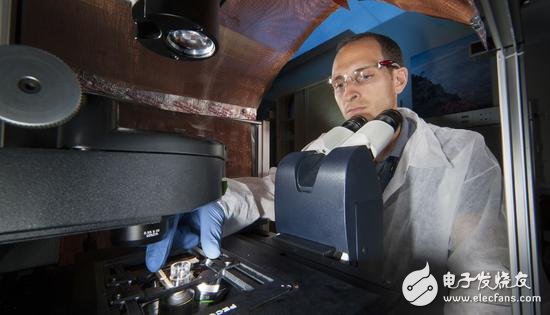Researchers are currently improving and improving the "chip brain" technology. Scientists believe that with the maturity of this technology, the future may not be able to conduct animal or even human clinical trials for many neurological diseases. On January 16th, it is reported that researchers are currently improving and perfecting the "chip brain" technology. Scientists believe that with the maturity of this technology, the future may not be able to conduct animal or even human clinical trials for many neurological diseases. Illustration: Dave Soscia, a researcher at Lawrence Livermore National Laboratory (LLNL), is examining the "chip brain" device under a microscope Researchers at Lawrence Livermore National Laboratory (LLNL) have developed a new use of "chip brain" technology: testing the effects of biological and chemical agents on the brain over time. The research results were published in the November 2017 issue of the PLoS One journal. The research is an important work of a research institute dedicated to the development of "chip brain" technology, and researchers hope that through this research, animals will not be tested for neurological diseases one day in the future. The so-called "chip brain" technology is essentially a network of researchers using semiconductor wires to make nanowires. When brain cells are introduced into the chip, they can use nanowires as scaffolds to construct functional neuronal circuits that mimic the interconnection of neurons in the brain. Once the simulated brain circuit is built, researchers can not only observe neural connectivity, but also the effects of disease and trauma. In January 2017, researchers at the John A. Paulson School of Engineering and Applied Science (SEAS) at Harvard University pioneered the use of this "chip brain" device in their research. This chip device enables researchers to identify differences between neurons based on differences in the location of neurons in the brain and the connections between different neurons, especially on the neurological basis of diseases such as schizophrenia. analysis. Researchers at the Australian National University later improved the architecture of the nanowires and developed the first ever operational neuron circuit. The latest applied research from Lawrence Livermore National Laboratory found that the technology can be used to study the long-term effects of biological and chemical agents on the brain. The current research team is primarily concerned with chemical exposures that military personnel may experience. Due to the prevalence of post-traumatic stress disorder, military personnel have become the most interesting patient population for neurological research. In their research, researchers focused on using their "chip brains" to study how brain cells are affected by a large number of chemicals and how these agents change brains over time. It is hoped that through a deeper understanding of the existing mechanisms, it is possible to develop corresponding antidote, treat or prevent patients, and protect groups such as military personnel in reality. The "Chip Brain" device used by the Lawrence Livermore National Laboratory team has customized specific inserts that enable them to model different regions of the brain and study the interconnectivity of the corresponding regions as needed. This also allows researchers to place multiple different types of neuronal cells in a much smaller area than ever before, enabling easy transitions between “macro world to micro worldâ€. Through this device, the research team is able to monitor the outbreaks of brain cells during communication (called “action potential patternsâ€) and let them know how this interaction has changed over time, especially when the brain is exposed. How to react in the case of chemical reagents, etc. Elizabeth Wheeler, principal researcher at iCHIP, explained in a LLNL press release: "Obviously, at high doses, we know that exposure will be harmful, but how will warriors who are exposed to low levels of chemicals for a long time? It's unclear. In the future, with this device, we may be able to predict how the brain will be affected. If we understand its impact, then we can work out a strategy to protect the warrior." Dave Soscia, an engineer at Lawrence Livermore National Laboratory and co-author of the paper, said: "Although we have a lot of gaps in the complete re-recognition of the in vitro brain, the related research is increasing the complexity of these devices. Sexuality and an important step in the right direction. Our idea is to ultimately give people enough confidence in these devices to see the effects of chemicals or drugs entering the platform environment and the results we see in the human body. similar." Biologist Kris Kulp further explained: "You can simulate someone who is temporarily exposed to chemicals on the battlefield and then observe what happens to the neurons within six months. Maybe they will The initial exposure recovered, but after six months from now, there are still some adverse effects. This is the only system that can perform such experiments on human cells." The next development plan is for the research team to work with computer scientists, statisticians, and others to analyze and simulate the experimental data provided by the device. China Stainless Steel Medical Device Processing,Stainless Steel Medical Device Processing, Stainless Steel Medical Device Processing Supplier ShenZhen Haofa Metal Precision Parts Technology Co., Ltd. , https://www.haofametals.com